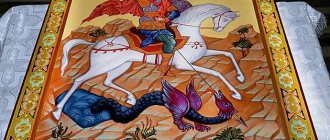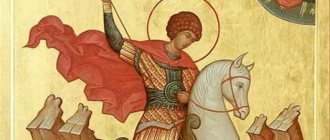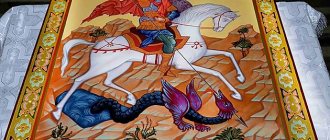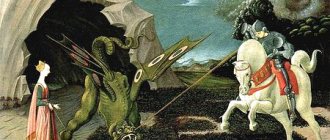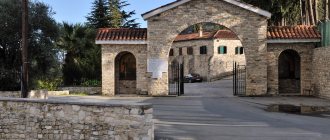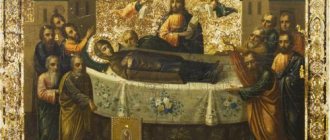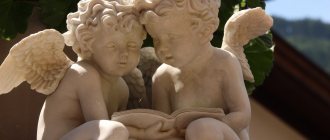"The Image of St. George in Russia and England"
Tyumen region, Khanty-Mansiysk Autonomous Okrug - Ugra, Khanty-Mansiysk city, Municipal budgetary educational institution "Secondary school with in-depth study of individual subjects No. 3" 10"B" class
1.Patron Saint. Saint George is one of the most famous saints in Christianity. Since ancient times, the name of St. George has become for Christians the personification of courage, protection of the weak and oppressed. A Christian saint, great martyr, also called George the Victorious, Saint George is the patron saint of England. It is symbolized by the emblem (a red cross on a white background) on the flag of England and part of the British flag. St. George became the official patron saint of England in the 13th century. [13]
In Rus', the veneration of St. George the Victorious received special significance. Since the 12th century, his name has entered the thousand-year history of the Russian state. The image of St. George the Victorious, slaying the serpent-Satan with a spear, is considered a patron and has adorned the coat of arms of the city of Moscow since the reign of the blessed Prince Dmitry Donskoy. St. George the Victorious is the patron saint of all valiant warriors who fight at different times for the faith and the Fatherland. On the coat of arms of the Russian Federation, on the chest of a double-headed eagle, in a red shield, there is a silver horseman slaying a dragon with a spear; in the time of Peter the Great (around the 1710s) he was first called “Saint George”. [2, 118]
George the Victorious is a common Christian saint, known, for example, under the name Iorge among the Germans, Georges among the French, Gergi among the Bulgarians, Izhik among the Czechs, Khizr or Uastirdzhi among the Ossetians. Moreover, he is known to the Islamic peoples of Africa and the Middle East, where he is called Jirjis and al-Khadr. [3, 419-420]. St. George is considered their patron by the cities of Moscow, Vladivostok, Genoa, Venice (together with the Apostle Mark), Barcelona, Beirut and Istanbul (Constantinople), Ferrari (Italy), as well as the countries of Portugal, England and Georgia (officially the last of them is called the Country St. George, Georgia). The so-called "St. George's Cross" became the basis of the English and Georgian flags. St. George is also considered the heavenly patron of Greece, Palestine, Lithuania, Malta, Ethiopia and the Spanish provinces of Aragon and Catalonia.
This means that the Russians and the residents of all these places have a common guardian. For example, he took Great Britain under his wing back in the 10th century, that is, even earlier than Moscow: even then churches dedicated to St. George were built there, and in the 14th century he was officially recognized as the patron saint of England. Tourists from these places are sometimes very surprised to see their saint on the coat of arms of the capital of Russia. Maybe he helps them feel at home with us - just as we do with them.
2. The personality of St. George the Victorious.
Who is Saint George, or St. George, so highly revered in a number of places? His name comes from the ancient Greek name Geysgypt (Georgios), derived from geshsht (georgos) - “farmer” (one of the epithets of Zeus).
With the exception of the fact of martyrdom, there is very little reliable information about Saint George. However, his veneration arose very early: from the sources that have reached us, he was first mentioned by Pope Gelasius in the decree “On Accepted Books” (De libris recipiendis) in 494. [4]. Researchers also disagree on whether George was a historical person. Thus, he believes that “the image of such a snake fighter, changing, stretches from deep, prehistoric antiquity.” [5, 114] On the contrary, earlier researchers [6, 462], [7, 109] consider George to be undoubtedly a historical person.
Basically, legends say that the Great Martyr George was the son of rich and pious parents who raised him in the Christian faith. According to the most common version, [8, 665-692] at the age of twenty, George became a tribune, one of the six military leaders at the head of each legion, and became the favorite of Emperor Diocletian, who went down in history as a cruel persecutor of Christians. George appeared before Emperor Diocletian as a confessor of Christ. George was forced to renounce his faith with threats and cruel torture, but the Lord and faith did not abandon the great martyr, and his wounds miraculously healed, and he was resurrected three times. Seeing this, many people believed in Christ and came to worship the still living martyr. Among their number was the empress, wife of Diocletian. By order of Diocletian, George was beheaded in Nicomedia in 303 on April 23, Good Friday.
The Great Martyr George is also called the Victorious for his courage and spiritual victory over his tormentors who could not force him to renounce Christianity, as well as for his miraculous help to people in danger. The relics of Saint George the Victorious were placed in the Palestinian city of Lida, in a temple bearing his name, and his head was kept in Rome in a temple also dedicated to him.
3. The Miracle of George about the Serpent.
The stories about the miracles of George are varied and widespread (the Miracle of the widow's column, the Miracle of the Saracen who shot an arrow at the icon, the Miracle of salvation from robbers - one of the most common stories, etc. [9, 112-125]. The Miracle of George The serpent is the main miracle of St. George. St. George is known throughout the world as the slayer of the evil dragon, he is often depicted as a knight carrying a shield with a red cross (or a banner with a red cross), usually sitting on a horse and at the moment of defeating the dragon. The reason for this - one of the most famous stories about the saint - the story of the battle with a dragon or serpent. The first of the images of the Miracle of George about the serpent preserved in Russian icon painting is found on a 12th-century fresco placed in the deaconry of the Church of St. George in Staraya Ladoga. [10, 10].
These images are based on legend, and the opinions of researchers differ even on whether this feat was intravital or posthumous. [11, 224; 9, 120]. They say that in the lake there lived a snake (or other similar animal) that devoured the people of that area. According to Kirpichnikov, these were the outskirts of the city of Gibal in Syrian Laodicea. [7, 115]. To quench the fury of the serpent, the superstitious people of that area began to regularly give him a young man or a girl by lot to be devoured. But when the choice fell on the daughter of the ruler of that area, a bright young man suddenly appeared on a white horse, struck the snake with a spear and saved the girl. This young man was the Holy Great Martyr George. With such a miraculous phenomenon, he stopped the destruction of young men and women and converted the inhabitants of that country, who had previously been pagans, to Christianity.
The first written mention of how St. George defeated the dragon is contained in the Golden Legends of 1265. [12]. Legends were considered “golden” not because they told stories about saints, but because this collection of stories was worth its weight in gold. Of course, it is very unlikely that he ever fought a dragon, and even more unlikely that he actually visited England. It is believed that the legend of the defeated dragon took root so well in England and was loved by the people, since there was already a similar myth in Anglo-Saxon legends. This story may also be a Christian version of the ancient Greek myth of Perseus, who saved the beautiful Andromeda from a sea monster. In Russian spiritual verse, the princess freed by Yegor the Brave was called Elizaveta (Lisaveta); according to one of the oldest editions of the miracle, the saint subdued the snake with prayer, and the princess brought him on her belt to the city, where people subsequently adopted Christianity. [10, 320].
The variety of symbolism of the duel between St. George and the serpent is interpreted differently; there are two descriptions of the miracle of George: saving the daughter of a pagan king from slaughter, killing the serpent with a spear and subduing the serpent through prayer. This feat converted many people to Christianity - and this fact rhymes with the idea of Moscow as the Third Rome and Russia as the guardian of Orthodoxy. Moscow, according to its coat of arms, is a fortress city, a warrior city. The image of St. George the Victorious on a horse symbolizes the victory over the devil - the “ancient serpent” Revelation. 12, 3; 20, 2 [8, 683]. In general, this is a symbol of the victory of Good over Evil and Light over Darkness, as St. George the Victorious did.
4. The emergence of the cult of St. George in England.
The English king of French blood, Richard I the Lionheart, who took part in the third crusade, in 1191 prayed for the help of the martyr George at his shrine in Lydda. Having won a brilliant victory, Richard began to venerate St. George as his heavenly patron and the patron of the entire royal army. The saint in the form of a warrior was close and understandable to the crusaders. There is a theory that the St. George's Cross came into use as a national emblem (but not a flag) during the Welsh War of 1275. There is an opinion that the Cross was adopted by England to endow the fleet with special symbols. The English monarch Richard the Lionheart initially chose St. George as his patron. [13] Then English ships raised a white flag with a red cross in order to gain certain benefits: the Cross was once a symbol of Genoa, and England thus fell under the protectorate of a powerful fleet.
In 1220, the name of St George was officially added to the English national calendar by King Henry III (1216–1272), nephew of Richard I. During the reign of Edward I (1272–1307), the banner of St. George began to be taken to the battlefield along with the banner of St. Edmund. In 1347, King Edward III founded the Order of the Garter, whose main patron was St. George. In 1415, the saint's feast day, April 23, received the status of a great holiday, and Saint George was proclaimed the patron saint of England. I am convinced that it is a mistake to think “that a patron saint can be appointed. But a saint must first earn popular recognition. ... Only universal veneration can suggest who should be the patron saint of the people.” [8, 673]
5. in Russia.
In Rus', the veneration of St. George the Victorious has received special significance; he has been known since the adoption of Christianity in the 10th century. Saint George became the ideal image of a warrior, defender of the Motherland. In Rus', icons depicting St. George became known already in the 12th century, in which a spear, sword, and chain mail symbolize the attributes of a warrior, and a scarlet cloak thrown over the shoulder is a symbol of martyrdom. [14, 139].
This saint was perceived as the patron saint of the entire Russian people. Thousands of churches bore his name, and also became a favorite name in all layers of the Russian people. The image of him on a horse and slaying a snake was included in the coat of arms of the Russian state. The basis of this veneration may be the ancient Russian cult of Dazhbog, who, before the Baptism of Rus', was also considered the patron and ancestor of the Russian people. People ascribe to St. George the Victorious the features of Dazhbog: the time of celebration of the days of St. George “Yuri Spring” (April 23) and “Yuri Autumn” (November 3) fell around the time when Dazhbog was honored in pagan Rus'. Also at this time the cycle of agricultural work was opened and closed.
Among Russian peasants, Saint George is known by many names, for example, Yagoria, Yegor the Brave, Yuri, Georga, Yurya, Yurka. The Russians saw in this saint a special representative and guardian of the Russian land and revered him as a hero-demigod; he became the center of Russian spiritual poems about Saint Yegor the Brave. According to the opinion, “the consonance of the word mountains with the idea of a mountain and the names of the fabulous heroes Vertigora and Svyatogor opened the way for Yegor the Brave to organize our earthly nature.” [10, 201] A considerable number of signs and observations were associated with St. George’s Day, by which peasants guessed about the harvest and the weather: “There will be frost in Yegorya - there will be millet and oats”, “Yuri begins field work, Yuri finishes”, “Yegory with water, and Nikola with grass,” etc.
Until the 15th century, the face of St. George alone constituted the state emblem of our Fatherland. In Ancient Rus', the image of St. George was stamped on Moscow coins (a horseman with a spear - hence the name “kopek”). At the beginning of the 11th century, the image of St. George first appears on coins and seals of Vladimir’s son (reigned from 1016 to 1054), who took the name Yuri (George). Yaroslav the Wise contributed greatly to the spread and establishment of the cult of St. George in Rus'. In honor of his patron saint, he founded the city of Yuryev (now Tartu) in 1030 and founded the Yuryev Monastery in Novgorod in the same year; later St. George’s Cathedral was built there. In 1037, Yaroslav began the construction of the St. George Monastery in Kyiv and erected the Church of St. George in it, and established the day of the consecration of the temple on November 26, 1051 as an annual holiday - “St. George’s Day,” or the day of autumn St. George. The founder of Moscow, Yuri Dolgoruky, continued this tradition by founding the city of Yuryev-Polsky in 1152, where the famous St. George Cathedral was built in 1230-34. In the same 1152, he built the Church of St. George at the new princely court in Vladimir. [15, 96-110].
6.Veneration of St. George the Victorious in Russia.
On the day of remembrance of St. George on April 23, there was a custom to serve prayers, asking for fertility, and also to bless water. In this regard, the people often called St. George the Water-Bearer, and the water (especially the water of rain and snow) consecrated on St. George’s Day is popularly called “St. George’s Dew”; fields and crops are sprinkled with it during the religious procession. Saint George provided assistance by appearing on horseback, therefore he was considered the patron and guardian of cattle breeding. On Georgiev, or Yegoryev's day, residents drove their livestock out to pasture after winter with prayer services and sprinkling of livestock and shepherds with holy water. The Day of the Great Martyr George is also popularly called “Yuryev Day”, it was very significant, because the majority of the population of Russia for a long time before the abolition of serfdom were peasants; on this day, before the reign of Boris Godunov, peasants could move to another landowner from the oppressor their master, it was a day for them of a possible change in life. [3, 419-420]
Moscow is the only city in Russia that celebrates the day of its coat of arms and flag. The celebration takes place, as you might guess, on May 6 (according to the old calendar, April 23) - the day dedicated to the holy great martyr and Victorious George.
7. Celebrating and honoring the Day of the Patron of England.
In the midst of spring, on April 23, England celebrates the day of England's patron saint, St. George, who is honored for slaying a dragon that was terrorizing several English villages, although it is doubtful that St. George was even in England. This is essentially the English version of St. Patrick's Day. On this day the flag of England, known as the "St. Cross" is raised. George" (the St. George Cross), the British attach red roses (the emblem of England) to their clothes. Traditional English dishes are prepared for the festive table, such as roast beef and Yorkshire pudding, toad-in-the-hole sausages, etc. In addition, it is customary to sing English folk songs on this day. On the Sunday leading up to April 23, St George's Day marches are organized across England with the participation of troops from the St George's Day Special Service. However, in most countries the holiday is celebrated on other days, for example, Americans celebrate it on the 4th of July with fireworks. The breadth of celebrations cannot be compared, for example, with the celebration of St. Patrick's Day in Ireland; St. George's Day is celebrated more modestly. For most people in England, St George's Day is just another regular working day. [13]
8. State awards of England in honor of St. George.
As already mentioned, in 1347, King Edward III founded the Order of the Garter, whose main patron was St. Georgy.
In 1940, as Luftwaffe planes bombed Britain, King George VI created a new award, the George Cross, to recognize civilians “for conspicuous gallantry.” This award is second in importance after the Victoria Cross. In particular, the island of Malta was awarded the George Cross for heroism shown during the Second World War.
At the beginning of the 20th century, the founder of the scouting movement, Lord Baden-Powell, chose St. George as the patron saint of scouts. [13]
9. State awards of Russia in honor of St. George.
In Rus', in honor of the patron saint of warriors, St. George the Victorious, the order was established on December 9 (November 26, old style) in 1769 by Empress Catherine II and was awarded to soldiers solely for bravery on the battlefield, at the same time the St. George Ribbon was established, the ribbon was worn depending on the class of the gentleman : either in the buttonhole, or on the neck, or over the right shoulder. The ribbon came with a lifelong salary. After the death of the owner, it was inherited, but due to the commission of a shameful offense it could be confiscated from the owner. The traditional interpretation of the colors of the St. George's Ribbon states that black means smoke, orange means flame.
The Order of St. George the Victorious was awarded to outstanding Russian commanders, including Alexander Suvorov and Mikhail Kutuzov. Since 1849, the names of his gentlemen were written on marble plaques in the St. George Hall of the Kremlin. The order had four degrees of distinction, and during the entire existence of the order in the Russian Empire, more than 10 thousand people were awarded it. Of these, only 23 people received George of the 1st degree and only four became full holders of the order: -Kutuzov, -de Tolly, -Zabalkansky, -Erivansky. In 2000, the Order of St. George was returned to the status of the highest military award of the Russian Federation. The first holder of the restored Order of St. George was in 2008 the commander of the North Caucasus Military District, Colonel General Sergei Makarov, for the successful conduct of the operation during the Georgian-Ossetian war.
There was another award, the insignia of the military order - an award badge for soldiers and non-commissioned officers of the Russian army from 1807 to 1917 - the St. George Cross, established by Emperor Alexander I. The motto of the award: “For service and courage.” For centuries, there was no higher military honor in Russia than the “Knight of St. George”.
In 1819, by decree of Emperor Alexander I, the St. George flag was established to reward the crew of the ship; its sailors received the right to wear the St. George ribbon on their cap. St. George's silver pipes appeared in 1805. They were entwined with a St. George ribbon with tassels made of silver thread, and the sign of the Order of St. George was also attached to the bell of the St. George trumpets.
After the 1917 revolution, the officer's Order of St. George was abolished. As for the soldier’s St. George Cross, its wearing was not officially legalized, however, after the Order of Glory appeared in the system of Soviet awards, which was in many ways similar to the “soldier’s St. George”, there was an opinion to legalize the old award, but this resolution was not adopted. The newspaper Krasnaya Zvezda wrote: The established Order of Glory is, as it were, a successor to the old soldier George.” The Order of Glory was established on November 8, 1943, and privates and sergeants of the Red Army, and in aviation those with the rank of junior lieutenant, were entitled to receive this award. It was awarded only for personal merit; it was not awarded to military units and formations. The color of the order ribbon and many provisions of the order's statute completely repeated the officer's St. George Cross. The Decree of the President of the Russian Federation dated March 2, 1994 states: “The military Order of St. George and the Insignia of St. George’s Cross are preserved in the system of state awards.”
Another award of great historical significance is the Victory Medal. The full name of this award is the Medal “For Victory over Germany in the Great Patriotic War of 1941-1945.” The ribbon is the same as on the Order of Glory and the Order of St. George, and it was established on May 9, 1945 by a special decree.
In continuation of the traditions of the St. George ribbon in the USSR, on June 10, 1942, the “Guards Ribbon” was established. The Guards ribbon was used to decorate the “Naval Guard” breastplate, as well as on Red Navy caps (peakless caps). Guards St. George Ribbon - a two-color ribbon for the Order of St. George, the St. George Cross, the Order of Glory, the St. George Medal and the medal "For Victory over Germany" - which, with minor changes, entered the Soviet award system under the name "Guards Ribbon" as a special insignia, and in People revered it as the GEORGE RIBBON.
With the start of the “St. George Ribbon” campaign in 2005, in the Russian media, the Soviet “Guards Ribbon” also began to be called “St. George’s Ribbon”. Unlike the order ribbon, it is given freely to everyone who attaches it to clothes, bags and car antennas as a sign of respect for the feat of veterans of the Great Patriotic War. The motto of such an action is “I remember, I am proud.” [15, 124-150]
10. Since 2007, on December 9, Russia annually celebrates the Day of Heroes of the Fatherland. On this day, Heroes of the Soviet Union, the Russian Federation, holders of the Order of St. George the Victorious and holders of three degrees of the Order of Glory are honored. Let us note that in Russia until 1914, December 9 was celebrated as the holiday of the Knights of St. George. On the eve and on the Day of Heroes of the Fatherland, sports competitions are held in Ugra, and in educational institutions there are lessons, classroom hours, school open events, quizzes and round tables about the exploits of Russians. Thematic media exhibitions about the heroes of the Fatherland, lectures, photo competitions and film screenings are opening in libraries, museums and cultural and leisure centers of the Autonomous Okrug. On December 9, 2013, ceremonial receptions were resumed in the St. George Hall of the Grand Kremlin Palace with the invitation of Heroes of the Soviet Union, Heroes of the Russian Federation, full holders of the Orders of Glory and St. George.
According to data presented by Lyudmila Shorokhova (Tyumen.ru), 123 Heroes of the Fatherland live in the Tyumen region, of which 14 are full holders of the Order of Glory. The full list and found photos are presented in Appendix 2. One of the full holders of the Order of Glory is our fellow countryman, a Ugra resident - commander of the rifle squad of the 521st Rifle Regiment (133rd Rifle Division, 27th Army, 2nd Ukrainian Front), sergeant . Since 2002 he lived in the city of Surgut (Khanty-Mansiysk Autonomous Okrug). Died on June 8, 2007.
I was especially interested in the personality of Yakin Khabibulla Khayrullovich (September 25, 1923 – June 7, 2009), also our fellow countryman from the Tyumen region. Habibullah's father, Khairullah Yakin, was a participant in the First World War and a full Knight of St. George. Seeing off his son to the front, he gave the order: “Do not disgrace the family name.” And the son fully fulfilled this order, returning from the war alive, a full holder of the Order of Glory, two Orders of the Red Star, the medal “For Courage” and many other awards. A worthy son of a worthy father! Read his words, they sound like the anthem of a courageous generation that brought our Motherland out of the flames of a terrible war: “We have withstood all the tests. Even after surviving, we never said that ... we had accomplished a real feat. We believed and still believe that we honestly fulfilled our civic duty and military oath. These words apply entirely to every war veteran, no matter where he fought.”
George was born and raised in a Christian family
Saint George the Victorious was born into a wealthy Christian family in the Palestinian city of Beirut (Belit), in the Lebanese Mountains. Even as a boy, he was distinguished by incredible courage and intelligence.
Great Martyr George, icon, first third of the 16th century
Father George died a painful death for his faith. The boy was raised by his mother. In his adolescence, George entered service in the Roman army. Soon Emperor Diocletian noticed him and accepted him into the imperial guard.
George stood up for Christians and confessed the Lord in the presence of the emperor
The emperor was an ardent supporter of paganism; he went down in history as one of the cruelest oppressors of Christians. Once, having heard the verdict about the torn apart of Christians, the Great Martyr George was imbued with spiritual compassion for them.
Fragment of the life of St. George the Victorious. Great Martyr George before the Tsars
He distributed all his property to the poor, gave freedom to his slaves, and when he came to the emperor, he confessed his faith in Christ. Diocletian forced the warrior to renounce the Lord, but the saint again and again confessed the true faith.
The Emperor subjected Saint George to cruel torture for his faith in Christ.
The ruler then ordered to subject the saint to painful torture. They threw the warrior into prison, his feet were shackled in heavy stocks, and a block of stone was placed on his chest. St. George the Victorious bravely endured the torment, continuing to glorify the Lord.
Fragment of life. St. George the Victorious in stocks. Icon, Bulgaria, National Historical Museum. 17th century
The executioners beat the unfortunate man with ox whips, threw his naked body into quicklime, and wheeled him on the wheel, but they could not break his true faith; the saint continued to call on the Lord for help.
During torture, the Lord appeared to the Great Martyr George
The torture of the Saint continued for seven days. Suddenly the sky turned black and the Voice of God was heard:
“I am with you, warrior, do not be afraid.”
An angel immediately appeared in the Divine glow and healed George with one touch.
Diocletian - Roman Emperor
Seeing such a miracle, forty thousand pagans believed in Christ. The imperial soldiers dragged George into the palace. The ruler called the Magi to brew a witchcraft potion.
The potion had no effect on the righteous warrior; he continued to pray and glorify Christ. And when, in front of the enraged ruler, the saint resurrected a dead man with prayers to the Lord, Diocletian ordered to lock George in prison.
People reached out to the prisoner with requests for healing and resurrection. Some asked to resurrect cattle, others to heal a child.
Icon of St. George the Victorious killing the serpent from the lake, in Beirut
George renounced power and chose death for the true faith
Dying, George did not stop praying. The Lord appeared to him again and kissed him and placed the crown of a martyr on him.
The emperor then offered the saint to become a co-ruler and renounce the Christian faith, or his head would be cut off. George refused the offer and put his head under a sharp sword.
Icon of the Holy Great Martyr George the Victorious “The Miracle of George about the Serpent with a Life in 16 Marks.” 17th century
The saint died at the beginning of the 4th century. The life of the holy great martyr was short-lived, so a brief summary of his righteous life was contained in several paragraphs. However, his biography will be fascinating for both children and adults.
Miracle of George about the serpent
St. George slaying the dragon.
Hood. Albrecht Altdorfer, early XVI century The legend says that in the vicinity of the city of Beirut near the Lebanese mountains[1] (in a number of texts the fictitious city of Lasiya[2] or “ Ebal, in the land of Palestine”
"[3], and Jacob of Voraginsky had the city of Silene in Libya) in the lake there lived a snake that attacked people.
The city was ruled by a king “ a dirty idolater, a lawless and wicked man, merciless and unmerciful to those who believe in Christ
.”
The people, frightened by the monster, came to him, the king offered to make a list of the townspeople and, one by one, give their children to be torn to pieces by the snake, promising, when his turn comes, to give his daughter to death. Having fulfilled his promise, the king “ dressed his daughter in purple and fine linen, adorned her with gold and precious stones and pearls
” and ordered her to be taken to the serpent.
The holy and great martyr, sufferer for the faith of Christ George, a warrior honored by the heavenly king, who lived even after death, shining with great miracles, by God's permission, wanting to save us who were perishing, to save our city from this scourge, at that very hour he was on the spot Tom in the form of a simple warrior...[3]
— “The Miracle of George about the Serpent” (16th century list)
In the Greek editions of the legend, the miracle is described as the only one during his lifetime (the Slavic tradition considers all the miracles of George to be posthumous [4]) and it is reported that George was a military leader, “ his army was disbanded, and he himself went to the Cappadocia land, his fatherland
».
Seeing the crying princess, he asked her about the reason for her grief and, having learned about the monster, promised to save her. Then, “ making the sign of the cross and calling on the Lord, with the words: “in the name of the Father, and the Son, and the Holy Spirit,” he rushed on his horse towards the serpent, shaking his spear and, striking the serpent with force in the larynx, struck him and pressed him to the ground; the saint's horse trampled the snake underfoot
".[1]
In some versions of the story, the serpent was defeated only by the power of the saint's prayer.[2] Then George ordered the princess to tie the snake with a belt and lead it to the city. The people were surprised by the princess’s return, and when they saw the snake, they began to run away in horror. George addressed them with the words: George kills the snake in front of the townspeople (Vittore Carpaccio, 1502-1507)
«Do not be afraid! if you believe in Christ, in whom I believe, you will now see your salvation
"
The king, coming out to meet him, said to him: “ What is your name, my lord?
“He answered: “
The name is George
.”
Then the people exclaimed all as one, saying: “ By you we believe in the one God Almighty and in the one Son of Him, our Lord Jesus Christ, and in the Holy Life-Giving Spirit
.”
George beheaded the snake with a sword, the residents carried the corpse out of the city and burned it. This miracle contributed to the conversion of local residents to Christianity; according to legend, many people were baptized (in different lists from 25,000[1] to 240,000[2]), and a church was built in the city in honor of the Mother of God.
The relics of the Great Martyr George the Victorious are located in the temple of the same name in the city of Lydda
According to his life, Saint George was buried in Israel, in the city of Lydda, where a temple of the Jerusalem Orthodox Church was erected in his honor. In this temple there is an ark with the relics of the Saint.
However, many churches around the world claim the presence of parts of the shrine, in particular the head of George. The Right Hand of the Victorious is located in the Xenophon Monastery on Mount Athos.
Ark with the right hand of the Great Martyr George in the monastery of Xenophon on Mount Athos in Greece
A brief history of the image of St. George the Victorious on the State symbols of Russia
Since the time of Dmitry Donskoy, for his feat, the Holy Great Martyr George the Victorious was considered the patron saint of the Russian army and symbolized victory over dark forces. His image was placed on state seals.
A horseman killing a snake appears on the coat of arms of the Moscow Principality during the reign of Ivan III. Officially, the coat of arms of Moscow was approved in 1781.
The photo shows St. George the Victorious on the coat of arms of Moscow
The image of St. George the Victorious is also present on the modern coat of arms of Russia, as a symbol of military valor.
Think yourself
Let's start with today. Let us turn directly to the image on the coat of arms of Moscow:
We see a horseman in armor striking a strange creature with a spear, resembling a snake with four clawed paws, wings and a crocodile mouth. What is this strange animal, the victory over which needed to be immortalized in city symbols? Or maybe it's just a symbol? Exactly the same as this victory itself?.. Let's look at earlier versions of this image (coat of arms of Moscow, 1730):
We see the same plot, but a little earlier - this is how it was in 1730. The Snake's body has noticeably shrunk here. However, it would be more correct to say that for some reason the Snake in later versions was added with two more legs. Let's take a break from the naive worldview that today is commonly attributed to our immediate ancestors, let's focus on the symbolism inherent to man at all times, and try to answer the question: who does this Serpent remind us of? Let's look at the following picture:
Similar, isn't it? But this is the coat of arms of one of the kingdoms of that period. To make it clearer, here it is in a modern interpretation:
So who does St. defeat? Georgy, if we turn to symbolism and not take the drawing literally? He defeats the Kazan kingdom. The last of the drawings presents us with the modern coat of arms of the city of Kazan...
Could it be that in honor of the victory over the great Kazan kingdom, similar memorial symbols appeared on the coat of arms of the capital of the Principality of Moscow? More than. But wait, wasn’t Kazan taken by Ivan the Terrible? What does Georgiy have to do with it, since there were no “Georges” in power at that time? Surprisingly, the answer lies in the nickname of Ivan IV - “The Terrible”.
As we remember, Greek names were popular in Muscovy at that time, and George was one of them. But this name has variations. For example – Egoriy. This is what the Pomors called St. George, which can be seen in the example of the White Sea epic in verse, in such works as “About Yegor the Brave” or “Egory and the Serpent”, which are presented in the works of A.V. Markov, who discovered epic culture at the beginning of the 20th century among the Pomors. So, “Egory” is not the only variant of the name “George”. The second one is more consistent with the content...
Ivan IV was called the Terrible. However, taking into account the fact that during his entire reign - 42 years! - about 4,000 people were executed, and all decisions were approved by the Boyar Duma, and against the background of the atrocities committed by European rulers, it would be fitting to award him with the epithet “Peace-loving”, not “Terrible”. It should be recognized that his nickname would have been given not for the conduct of domestic politics, but for something else. It’s clear why: in addition to domestic politics, there is foreign policy. Ivan IV (as, indeed, his father) was nicknamed the Terrible solely for his belligerence.
But in Greek, to which all royal names go back, the word “warlike” corresponds to the name Igor. Igor... Egor... Which vowel system should be preferred in this or that land? It is known that the common people did not call Tsar Ivan IV “Terrible,” and even the notorious “Kazan Chronicler,” dedicated to the capture of Kazan, spoke of the tsar with respect. It is logical to assume that the king was called formidable by those who were close to power, well trained and undoubtedly spoke Greek, at least to a minimum extent. So it turns out: Ivan the Militant.
What is a nickname if not a middle name? “Warlike” - Igor (Egoriy) - Georgy. On the other hand, “George” has its own meaning in Greek and it means “farmer.” Would it be fair to put the “farmer” next to the “warrior” – George next to Igor? One can launch into lengthy explanations that the scribes, as always, mixed everything up and turned the warlike “Igor” through “Egoriy” into “George.” Of course, it could be so, but something else is more likely.
Agree that such a grandiose event, which without a doubt is the victory over the greatest kingdom of Kazan, could not help but be reflected not only in heraldry, but also in folk art. And it really had an impact. It may be spontaneously, but most likely, thanks to people specially trained by the sovereign of Moscow, heroic tales about the deeds of the Moscow prince began to appear in various lands of the Principality of Moscow. One must think that it is precisely because of the centralized distribution and the agreed upon details of the legend that these legends differ so little and insignificantly from each other, in the Moscow lands, in the Yaroslavl lands, and in the Pomeranian lands. But let's turn directly to this “folk” creativity. We are talking about the story of “Nikita Kozhemyak”. This tale features the well-known Serpent Gorynych, whom the hero Nikita will have to defeat. We are interested in one very characteristic fragment from this legend: The Hero and the Serpent are engaged in dividing the earth between themselves. Moreover, not just any way, but by land surveying, that is, they build a wide ditch along the borders of their lands (kingdoms). In our case, the name George (Greek: tiller) perfectly reflects this process.
Of course, the plot of this tale can be considered a simple fiction, not relevant to our case, if not for a number of coincidences, which together cease to be considered as such. So: 1) both on the coat of arms of the Moscow principality and in the legend about Nikita Kozhemyak the struggle with a certain Serpent is reflected; 2) the winner of the Snake on the Moscow coat of arms bears the name George, that is, “farmer”, the hero of the fairy tale and the Snake himself do the same thing; 3) to this day, traces of very old defensive structures have indeed been preserved in the area of the Volga River; 4) Nikita from the fairy tale, who plowed the boundary with the Serpent, translated from Greek as “Winner”, St. George (Greek: tiller) also bears the nickname "Victorious".
It becomes clear why the name “Ivan” is so popular in Russian fairy tales - “Ivan, by God’s grace, the ruler of all Rus' and the Grand Duke,” is truly worthy of imitation. It no longer raises questions why George the Victorious appears on the coat of arms of the Moscow Principality, slaying the “Snake” - this is nothing more than a reflection of the plot of the capture of Kazan by Ivan IV. Moreover, it becomes clear what kind of “snake” this is and what it symbolizes. Of course, this fantastic creature has nothing to do with the snake. This is nothing more than a symbol of the highest power - the Basilisk. The word also has Greek roots and means "king". “Basilevs” and “Basily” have the same meaning.
It would be very interesting to look at a map of Tartary before Ivan the Terrible’s conquest of the Novgorod, Kazan and Astrakhan kingdoms. Were they independent states or part of Tartaria? The earliest map we have with marked boundaries is dated 1593. (By Gerard de Jode, Antwerp) shows them as parts of Muscovy.
Probably, on the coat of arms of the Moscow principality we can observe one of the stages of the fall of Great Tartary, marking the capture of the Kazan kingdom. Let us pay attention to the fact that it was the symbol of royal power and Kazan - the basilisk - that was trampled upon on the Moscow and Russian coats of arms:
It is probably no coincidence that Kazan was given so much importance. Probably, it was Kazan that at that time had full power over the surrounding principalities and, before its fall and the subsequent transfer of the capital to Tobolsk, was the center of Great Tartary.
PS: Pay attention to the three crowns that are present in the coat of arms of the Russian kingdom. Next time we will turn to the epic creation that served as the basis for the plots of almost all so-called Russian folk tales: “The Tale and the Three Kingdoms: Copper, Silver and Gold”, and at the same time we will try to find out where the three Russian kingdoms were and where they disappeared: Slavia, Artania and Kuyavia.
The legendary feat of St. George the Victorious has become an iconic image of a horseman killing a snake
The image of George killing the serpent is based on the legend of the miracles of the great martyr. A terrible monster has appeared in the lake of the city of Beirut, eating the townspeople and devastating the crops.
To pay off the evil monster, the residents decided to sacrifice the king’s daughter to him. The brave warrior stood up for the monster’s chosen one, crossed himself, prayed and struck the snake with one blow of his spear.
Painting by Paolo Uccello “The Battle of St. George with the Serpent”
By killing the black snake, St. George the Victorious saved the princess from certain death, for which he became famous not only in the countries of the East, but also in Europe. The English king declared the martyr his patron.
Who did St. George the Victorious kill?
Researchers from the International Union of Cryptozoologists, which brought together 800 scientists from 20 countries, recently came to the conclusion that the coat of arms of Moscow depicts a real, not a mythical monster. Monstrous reality
The image of St. George the Victorious, a serpent-fighting horseman with a spear, appeared on the coat of arms of the Moscow Principality under Ivan III (1462 - 1505). The seal of Grand Duke Ivan (1479) has also survived to this day, on which there is a warrior striking a small winged dragon with a spear. And in the drawing from a 12th century fresco. (Church of St. George in Staraya Ladoga) this is how the incredible is depicted: a centipede monster with a crocodile’s tail, a dog’s head and wings like an eagle. He is led on a string, like a pet.
What are these - painted fairy tales of our ancestors or a real MONSTER reality?
“This same Serpent could well have once lived in Russian forests,” says Irina TsAREVA, head of the scientific environmental program RICANN (Russian Intellectual Corps of Current Scientific Directions). — Numerous legends clearly indicate that bloodthirsty dragons once lived in the European part of Russia. They had a ferocious disposition: they pounced on foot and horsemen and tore them to pieces. Russian heroes fought with them. And in Western Europe, they were destroyed by medieval knights in order to win the favorable gaze of their ladies. And who knows, perhaps, not without heroic participation, some species of prehistoric lizards, which even survived the Ice Age, disappeared from the face of the earth.
An amazing entry from the chronicle
“This is not as absurd as it might seem at first glance,” says Olga ZAKHAROVA, candidate of historical sciences, specialist in mythology. “After all, it’s not only legends and fairy tales that tell about mysterious monsters whose descriptions resemble lizards. There are other, completely trustworthy sources with information about unknown dragon-like creatures. For example, in the thirtieth volume of the Complete Collection of Russian Chronicles one can find an amazing entry dating back to 1582 from Novgorod: “...In the summer the Corcodiles came out of the river and closed the path, eating many people, and people were terrified and praying to God throughout the whole earth. And she hid again and beat up others. That same year, Grand Duke Ivan Ivanovich reposed in Sloboda, on the 14th day of December...” The question arises: what are these “corcodiles” - crocodiles (?) - that came out of the river and attacked people? After all, it happened not in distant Africa, but near Novgorod.
- And what? - I’m interested.
“Perhaps in Rus' this is how they dubbed dragons - a land-based variety of sea serpents,” says Olga Vladimirovna. - And mention of these monsters can be found in Aristotle and Euripides, and then in chronicles and historical works of the Middle Ages. The English monk Bartholomew in his book “The Properties of Things” writes: “The dragon is the largest of all serpents, often it comes out of its cave, rises into the air, with its movement it produces a strong wind, and the sea swells from its sting, and it has a crest , and he sticks out his tongue, and he has teeth like a saw, and his strength lies not only in his teeth, but in his tail, and he hurts not only with his bite, but also with his sting. He kills everyone he meets on his way."
An ancient description of the monster, dated 600 AD, has also been preserved. BC: “The dragon is the largest of snakes and, in general, the largest of all creatures living on Earth. It has a large snout and narrow blowholes through which it breathes and sticks out its tongue.”
Encounters with the serpent
- Are there more modern descriptions?
- I’m interested. “Nothing is known about dragons today, but there is a great deal of evidence of encounters with a sea serpent,” says Olga Vladimirovna. — A couple of years ago, a friend of mine from ITAR-TASS called me and told me that at one of the whaling bases in the Indian Ocean, helicopter pilots twice observed animals that looked like gigantic snakes, 10 - 15 m in length. The snake lay calmly on the surface of the water. The helicopter pilot descended 30 m, and observer Igor Dolzhenko, using binoculars, was able to determine: the sea monster was a meter thick and had a light brown color. A few minutes later a second such snake was spotted.
And the famous TV presenter Yuri Senkevich said: “In one experiment related to seismic, an explosion was required at great depths in the ocean. And together with my friend - mind you, a biologist - we suddenly saw how, at a distance of about half a kilometer behind the stern of the research vessel, some huge body rose above the water and a moment later disappeared into the depths.”
The existence of the monster is confirmed by amazing finds. In 1932, a strong earthquake occurred off the coast of North America, washing ashore many corpses of sea inhabitants, including a sea serpent. The animal had a pointed head and a mouth full of sharp teeth. And in 1947, on the western shore of Vancouver Island in the Atlantic, a skeleton of an amazing creature 12 meters long with a head resembling the head of a ram was found.
- So monsters exist?
“The fact that people really saw a sea serpent is beyond doubt,” says biologist and researcher of anomalous phenomena Evgeny POTAPOV. - And the descriptions of monsters differ from each other because sea snakes can belong to different species.
BY THE WAY
The Asian calendar is divided into 12-year cycles, each of which is associated with a specific animal. People born in the year of the Dragon are said to be the best leaders, since their character combines strength with generosity.
https://www.kp.ru/daily/23550/42470/
The Orthodox Church remembers Saint George three times a year
The Russian Orthodox Church celebrates St. George's Day on May 6 (April 23, old style). On this day in 303, the Great Martyr George was executed.
Orthodox Georgia celebrates the special day of remembrance of the Saint, November 10, as the day of the wheeling of the holy great martyr. In 1891, in the Georgian village of Kakha, a temple was built in honor of St. George the Victorious. People of different faiths flock to this temple to honor the memory of the saint.
Life, fragment of the wheeling of St. George the Victorious. Pantokrator Monastery, Athos, 17th century
On November 16, the consecration of the Church of the Great Martyr George in Lydda took place, where the relics of the saint are located, and the chain in which he was chained during torture. On this day, the Russian Orthodox Church also remembers the Saint.
On December 9 (November 26) we remember the consecration of the Kyiv Church of St. George.
Prayers
Troparion, tone 4
As a liberator of captives/ and a defender of the poor,/ a physician of the infirm,/ a champion of kings,/ the victorious Great Martyr George,/ pray to Christ God// to save our souls.
Troparion, same voice
You fought a good fight, / more passionate than Christ, / through faith you also rebuked the tormentors of wickedness, / you offered a sacrifice acceptable to God. / Moreover, you also received a crown. You/ and through your prayers, O saints// you grant forgiveness of sins to all.
Kontakion, tone 4 (Similar to: Ascended:)
Crafted by God, you showed yourself/ to be a most honest worker of piety,/ having gathered the handles of virtues for yourself:/ having sowed in tears, reaped with joy,/ having suffered through blood, you received Christ/ and prayed by yours, holy ones, by yours// you grant forgiveness of sins to all.
Kontakion from the Service of the Renewal of the Church of St. George in Lydda, tone 8 (Similar to: Collected:)
To Thy chosen and speedy intercession/ having resorted, faithfully,/ we pray to be delivered, O passion-bearer of Christ,/ from the temptation of the enemy who sings of thee,/ and all sorts of troubles and bitterness, and we call: // Rejoice, martyr George.
Troparion from the service of the consecration of the Church of the Great Martyr. George in Kyiv, voice 4
Today the ends of the world bless you,/ Divine miracles have been fulfilled,/ and the earth rejoices, having drunk your blood./ The people of the city of Kiev are celebrating the name of Christ/ with the consecration of the Divine Temple yours/ rejoiced with joy,/ passion-bearing George,/ chosen vessel of the Holy Spirit, servant of Christ./ Him pray with faith and supplication to those who come to your holy temple/ to grant cleansing of sins,// to pacify the world and save our souls.
Kontakion from the service of the consecration of the Church of the Great Martyr. George in Kyiv, voice 2 (Similar: Solid:)
The divine and crowned great martyr of Christ George, / in the face of victory over his enemies, / having gathered by faith in the consecrated temple, let us praise, / whom God was pleased to create in him I am his // One to rest in the saints.
A strong prayer to St. George the Victorious for help in any matter
“Oh holy martyr George! You are a miracle worker and protector of all people. Hear my prayer and do not ignore anyone who turns to You for help, for everyone needs Your support. Forgive us sinners, we repent and ask for the blessings of the Lord. I pray to You, Great Martyr, for health, deliverance from troubles, sorrows and grief. Strengthen my faith and illuminate my whole life with heavenly light. Support me in all my endeavors and never leave me, O great Saint George. Protect from evil, guide us on the true path, for we believe entirely in You, the patron of the army and the protector of people. May we glorify Your name, George, and may we never cease to honor You. Forever and ever. Amen"
Morning prayer to St. George the Victorious
Saint George protects everyone who needs him. Therefore, if you want to enlist his support, you should read this prayer on the morning of May 6:
“Holy George, warrior, savior and victorious! Please give me your protection and support. Do not leave me on the thorny and difficult path, for I need you. Help me in any matter, protect me and do not offend me. Forever and ever. Amen".
Saint George is an Orthodox righteous man who sacrificed his life for the sake of his faith. Every year on May 6, Christians remember his life, good deeds and deeds. On this day, prayers to the great martyr acquire truly miraculous power and are able to change people's lives for the better. In 2022, spend this day in righteousness to offer prayers to the saint in front of His image. We wish you happiness and don't forget to press the buttons and
Prayer for protection from enemies
Many Orthodox people know that St. George the Victorious was distinguished by courage and bravery. That is why the prayer for protection of this saint is especially effective and powerful:
“Oh, most holy martyr George! I turn to You in prayer for help. Help me, great protector! Protect me, my home and my entire family from enemies and enemies. Protect from evil and troubles. Don't let misfortunes and sorrows burst into my life. Let evil enemies who wish me troubles pass by. Let me live freely, quietly and peacefully. Protect, I pray to You, Most Holy One. May I glorify Your name! Forever and ever. Amen".
How does the Holy Great Martyr George the Victorious help?
The Orthodox have different versions, in which the martyr George and his holy icon help. In the Balkans, Romania and Greece, he is considered the patron saint of shepherds and farmers. In Bulgaria, prayers are offered to him for rain. It protects Georgians from evil and brings good luck in hunting. Helps get rid of snakes and rodents in Western Europe. Saint George is also revered by Muslims in Africa.
Statue of St. George the Victorious in Tbilisi, Georgia
What kind of snake did Saint George kill?
In our imagination, George, the martyred knight, is the dragon-slaying saint, but his most ancient representations tell us a very different story.
As a symbol of evil and paganism, the dragon often appears in stories about medieval saints. The list of holy dragon slayers is certainly a long one: Theodore, Sylvester, Margaret and Martha (who, however, just tamed a monster) are just the most famous. Next to them, St. Michael the Archangel fought the battle against this messenger of the Apocalypse. However, none of all the dragon slayers became the object of the same popular veneration as St. George, chosen as the patron saint of England, Portugal and many other countries.
We only know about him that he was a Cappadocian soldier martyred under Diocletian, but we have no other historical source about his life. Therefore, all stories about him are the result of medieval additions that enriched the original drawing over the centuries.
Traditional iconography of George is based on his most famous miracle, the slaying of the dragon. As Jacobus de Voragine recounts in The Golden Legend, this event is well known: the city was besieged by a terrible monster, and in order to keep it away, the citizens drew lots to decide which of the youngest in the city should be sacrificed to the monster.
Since the lot fell on the king's daughter, St. George appears on his horse and manages to neutralize the dragon (the scene is immortalized by artists). He then invites the princess to tie up the dragon, now domesticated, to bring him to the city: witnessing this amazing event, the king and the entire population converted to Christianity and, in the end, the dragon was killed.
Beginning in the 12th century, the image of fighting a satanic creature became increasingly common throughout Europe, as depicted in painting. In Western culture, the iconography of this saint is based mainly on this episode, and other miracles and his martyr are rarely depicted: the dragon becomes his characteristic feature. However, he was not always presented according to this model: on the contrary, at the beginning of his cult there was no dragon in his stories, let alone in his representations.
The oldest image of St. George dates back to the first half of the 10th century and was found in Armenia, in the Church of the Holy Cross, built on the island of Akdamar. Here the bas-relief depicts three saints on horseback, and among them George can be distinguished. The other two knights are Saint Sergius, slaying a ferocious animal (middle), and Saint Theodore, who is definitely fighting against a dragon (left).
In fact, at that time the holy dragon slayer was Theodore, a holy knight famous since the 7th century for defeating the monster. For this reason, in the early Middle Ages, dragons were associated only with this saint. In subsequent centuries, artists would continue to depict Saint Theodore alongside the dragon (as in the statue above a column in St. Mark's Square in Venice), but this iconography would become less and less common.
Until the 11th century, no story about St. George ever mentioned killing a dragon: he was revered simply as a warrior-martyr who converted infidel peoples. For this reason, the traditional image that represented him up to this point was a knight piercing a man with a spear, a symbol of pagan persecutor and heresy.
It was at this moment that a legend arose in Eastern culture that George also encountered a monster, perhaps based on those same illustrations. As a matter of fact, on frescoes and bas-reliefs the saint was always depicted together with Theodore, who fought against the dragon: artists of the early Middle Ages sometimes depicted two saints killing one serpent between them.
But then gradually it was George who began to be associated with the dragon. The first texts associated with this episode date back to the 11th century and include all the elements already known to us: the lake monster, the princess rescued from its jaws, the taming of the dragon that brought it to the city, the conversion of its inhabitants. The story of St. George and the dragon spread everywhere, but it would have remained associated with the eastern regions for a long time if not for the Crusades.
Christians easily identified themselves with the triumphant saint who had liberated the region from infidels: as the patron saint of the crusaders, no one was more suitable than George. In a very short time, the cult of St. George spread throughout Europe, as did the image of a knight slaying a dragon - in England, the first image of this kind dates back to the beginning of the 12th century. While in the eastern regions the monster looked more like a snake, the version brought by the Crusaders to the western lands grew in size and gained legs and wings, becoming the dragon we all know
Related posts:
On the icons St. George is depicted as a brave warrior
On icons, St. George the Victorious is mainly depicted on horseback, killing a huge black serpent. The image is considered as a symbol of the persistent, unshakable faith of the true God Jesus Christ. Neither torture, nor power, nor wealth could force Saint George to renounce Christianity.
Two most common types of icons of St. George the Victorious
Some examples of icons are framed with hagiographic stamps, which depict various fragments of such a short, but such a righteous life of the great martyr. This representation of the image refers to legends about miracles that occurred after the execution of the saint.
St. George the Victorious in the center of the double-headed eagle on the coat of arms of Russia
Also, the martyr George is depicted on icons as a brave warrior with a spear and sword in his hands.
Icons, like the saint himself, are familiar and revered in almost all countries of the world.
Who is St. George the Victorious
Great Martyr George was the son of rich and noble Christians from the city of Belit (now Beirut). George stood out for his strength, stature and beauty; he succeeded in military service and was loved by Emperor Diocletian. However, when under Diocletian, a fanatical pagan, persecution of Christians began, George did not hide his faith. Despite the emperor’s admonitions, George did not flinch and did not renounce Christianity. For this, after terrible torture, he was beheaded. The saint is credited with converting Diocletian's wife Queen Alexandra to Christianity, crushing idols in the temple of Apollo, and defeating the serpent that was ravaging the lands.
In Rus', George the Victorious was greatly revered; in the Russian tradition, his name was modified into Yegor (Yegor), this is how ordinary people were mainly called (the “noble” version - Yuri). Saint George, sitting on a horse and slaying a snake, was depicted on the coat of arms of the Russian state; now the image of this saint is on the coat of arms of Moscow.
Prayer to the Great Martyr George the Victorious
Troparion, tone 4
As the liberator of the captives, and the protector of the poor, the physician of the infirm, the champion of kings, the victorious Great Martyr George, pray to Christ God to save our souls.
Kontakion, tone 4
Cultivated by God, you showed yourself to be a most honest worker of piety, having collected the virtues of the handle for yourself: having sowed in tears, you reaped with joy; having suffered with your blood, you received Christ: and through your holy prayers, you grant forgiveness to all sins.
By leaving a comment, you accept the user agreement
